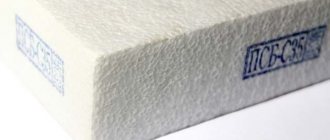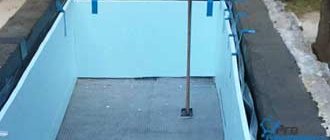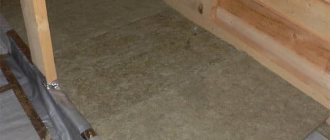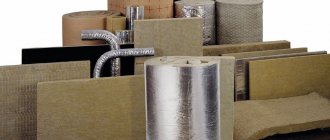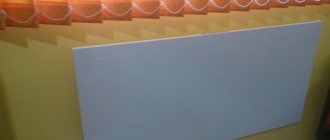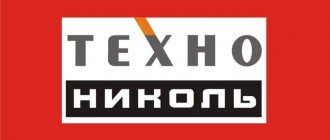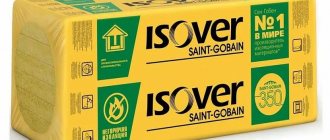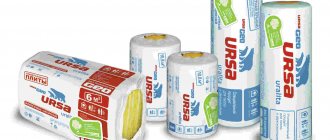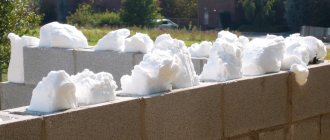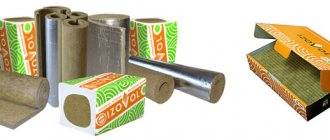In the cold season, many owners of apartments in high-rise buildings (not only “old buildings”, but also in “new buildings”), private houses/cottages, trade and industrial companies (including utilities) are faced with the problem of freezing walls on the inside and outside and condensation settling on pipes and gas pipelines. And this, in the context of rising tariffs for heat supply services, leads to serious financial losses. The modern building materials market, focusing on the needs of private and corporate consumers, is represented by a wide variety of thermal insulation materials. The most widespread types of traditional insulation materials are:
- glass wool;
- basalt thermal insulation;
- foil insulation;
- Styrofoam.
Most of them are based on mineral wool treated with various substances. One of the disadvantages of such insulation is its “sagging”, deformation over a long period of use, as well as a reduction in the volume of living space. However, modern industry does not stand still. By using the achievements of modern nanotechnology, a new type of innovative thermal insulation material was created - liquid ceramic insulation, which is used in both household and industrial areas.
- 2 Where it is used
- 3 Most popular brands of “insulating paint”
- 4 Advantages and disadvantages
- 5 Tips for Buyers
What is ceramic thermal insulation
Ceramic insulation can be applied with a compressor.
Liquid ceramic thermal insulation consists of two main components - ceramic vacuum spheres and a connecting polymer composition (mastic). In appearance and consistency it resembles thick paint. The initial color of the composition is white, but you can add a variety of colors. The size of the ceramic granules is very small, so much so that they are visually invisible.
It was invented as part of the space shuttle insulation program. Then the task was to develop an effective thermal insulation material that would have minimal weight. Every additional kilogram launched into orbit is a colossal expense, so the goals are very justified. Over time, the material became available for civil engineering.
Liquid ceramic thermal insulation can be applied in several ways:
- brush;
- roller;
- spray.
In the latter case, you need to dilute the paint with plain water. This is possible since the composition is made on an acrylic base, that is, it does not contain any solvents.
The thermal conductivity coefficient differs from different manufacturers, the lowest that could be found is 0.0012 W/m*C, but thermal conductivity is rarely indicated above 0.0025 W/m*C.
This insulation is not afraid of moisture, sunlight, is not blown by the wind and can withstand extremely high temperatures. Based on the stated characteristics, the ideal insulation is liquid ceramic thermal insulation. Reviews from those who have already tried this product are somewhat different from marketing ploys. We'll talk about this a little later.
The most popular manufacturers of insulation paint:
- Astratek;
- Corundum;
- Akterm.
Features of the composition
Ceramic liquid thermal insulation is practically no different in appearance from the acrylic paint we are used to.
Today, there are several types of insulating compounds, but almost all of them have the same structure:
- The basis of liquid ceramics is a water-acrylic mixture. It ensures uniform distribution of insulating components over the surface and helps to secure the thermal insulation.
- As additional components, various additives to improve the performance characteristics of the material. The most popular additives include artificial and natural rubbers, silicone, etc.
- The main component responsible for reducing heat loss by the treated surface is ceramic granules filled with highly rarefied air. The microscopic dimensions of the granules and the almost ideal spherical shape make it possible to apply the composition very thinly to the wall.
Material structure
Note! For high-quality varieties of liquid ceramic thermal insulation, subject to complete polymerization, the proportion of voids in the insulating layer is about 75-80%. This allows you to create an ultra-thin layer on the treated surface with a very high heat transfer resistance.
Advantages and disadvantages
Compared to traditional insulation, liquid heat insulator based on ceramic microspheres has a number of advantages:
- Firstly, when insulating a house from the outside, the useful volume of the room is not lost. A thin layer of paintable insulation cannot be compared with sheathing made of mineral wool or other porous materials, so for rooms with a small area, the use of this composition can be an excellent solution.
The principle of operation of thermal paint
- Secondly, the applied layer does not degrade over time. The guaranteed service life of a ceramic coating is up to 15 years , but with proper care (application of finishing and timely cleaning), this time can be at least doubled.
- Thirdly, the mass of the material is insignificant, due to which no additional load is created on the supporting structures. This advantage of the material is especially pronounced when finishing roofs.
- Another plus is the ease of surface treatment: liquid ceramics are applied no more difficult than ordinary paint, and therefore are excellent for insulating complex architectural forms and rooms with non-linear configurations.
Photo of the treated surface
Among other things, it is worth noting the compatibility of most compositions on the market with facade and interior paints, decorative plasters, etc. At the same time, no primer is required for finishing the ceramic layer!
Note! Insulation of pipelines, outbuildings, etc. can be carried out without decorative finishing - the aesthetic appearance of the coating after polymerization allows this.
When talking about the disadvantages of ceramic insulation, they most often mention the rather high cost of the material. However, if earlier, when only foreign brands were represented on the market, this was fair, today the situation has changed somewhat. Domestic brands, such as liquid ceramic thermal insulation coating Corundum, can be purchased at quite affordable prices.
Liquid thermal insulation: what is it?
Liquid thermal insulation is one of the types of insulation that is used to insulate facades, walls, pipes, etc. This material can be compared to sour cream or mastic in consistency. Liquid thermal insulation is usually applied in 2-3 thin layers. Moreover, it is important to wait until each of them dries. Only after this can a new layer be applied.
Most often, the base of thermal paint consists of acrylic. In addition, silicone, glass or ceramic microsphere are added.
Liquid thermal insulation for walls
Scope of application of ceramic insulation
Where other insulation materials are powerless, ceramic thermal insulation will help.
Recently, ceramic thermal insulation has been used wherever possible, and a program for insulating facades is even supported at the state level. This insulation is suitable for:
- application to stone and concrete surfaces from the outside and inside;
- reducing heat loss from pipelines;
- protection of metal structures.
As you can see, liquid ceramic insulation is a universal product that is not applicable only to wood. The reason for this is the vapor barrier qualities of the material, and as you know, wood breathes and this process should not be disrupted.
In everyday life, this type of insulation is applied to internal walls; it can be used to cover a heating buffer tank (battery tank); even a bathtub covered with this insulation paint will retain heat longer. Also, if you use liquid ceramic insulation on the basement floor from the inside, you can solve three problems at once:
- insulation;
- waterproofing;
- vapor barrier.
In this case, the material is suitable as an auxiliary measure, since the main protection of the walls of the basement is located outside. This is a bitumen hydro-vapor barrier and extruded polystyrene foam as insulation. When ceramic insulation is used to reduce heat loss from communications or metal tanks, additional layers of thermal insulation will also not hurt.
Buying tips
The significant price of ceramic insulating compounds is the reason why you should be very careful when purchasing material in a store or on the construction market.
Instructions that allow you to avoid making mistakes and buy a high-quality heat insulator are given below:
- The first thing you should pay attention to is the density of the mixture. High-quality insulation materials are characterized by an indicator of no more than 0.6 kg per 1 liter of product. Thus, a standard ten-liter bucket should not weigh more than 7.5 kg. Otherwise, we can safely say that the thermal insulation properties of the paint will be low.
"Korund" is one of the most popular brands
- Looking at the container with the material “through the light”, you can see its delamination. Typically, the lighter fraction containing ceramic spheres ends up on top. So the thicker the top layer, the more effectively the paint mixture will retain heat.
- The third test is to determine the structure of the mixture itself. Take some paint and rub it between your fingers. Microgranules should be felt as small roughness, and their absence should be considered a reason to choose a different brand.
It is these micrograins that can be felt with your fingertips.
It is also worth paying attention to the color of the paint. The vast majority of brands of liquid ceramic insulation are produced in white, so a gray or yellowish tint is evidence of violations in the manufacturing technology. Naturally, this does not apply to compositions into which a color pigment has previously been introduced.
Surface application
Ceramic thermal paint is quite easily applied to surfaces made of a wide variety of materials.
So if you decide to do the painting insulation work yourself, you just need to follow some recommendations:
- The wall to be painted must be cleaned of dust and debris. We open up the gaps and cracks and fill them with repair compound.
- We clean concrete slabs from “cement laitance”.
- Immediately before painting, we treat the wall with a sandblasting machine, an abrasive wheel or a wire brush.
- Ferrous metal surfaces are dusted and degreased. Non-ferrous metals require preliminary removal of the gloss and application of a primer such as VL-023 or VL-02.
- Mix the ceramic composition immediately before applying it to the wall. As a rule, mixing is carried out manually.
Note! To work with large volumes, the use of construction mixers is allowed, and the rotation speed should not exceed 150-200 rpm. At a higher speed of movement of the nozzle, destruction of ceramic granules and a decrease in heat-saving characteristics is possible.
- Mixing time by hand is from 10 to 15 minutes, with a mixer - 3-8 minutes.
- Some formulations require adding water before starting work. The volume of liquid depends on the brand of material and the purpose of using the insulation. The required proportions are usually indicated on the packaging, and can also be found on the manufacturer’s website.
Applying the composition with a brush
The most popular brands of “insulating paint”
Today, the most popular “insulating paints” in Russia are the following brands:
- Akterm;
- Astratek;
- Armor;
- Corundum;
- RE-THERM;
- Thermomet;
- Termolat and others.
Liquid insulation is packaged in plastic containers with a volume of 10 and 20 liters. The can has a recognizable company and brand logo.
Each company produces a whole line of liquid ceramic insulation, designed for different types of surfaces, different temperature conditions and having different technical and operational characteristics - as indicated on the surface of the container.
An article dedicated to the cheapest types of insulation can be found here:
Liquid thermal insulator TC Ceramic: specifics
Products of this brand are sold in the form of a suspension
containing acrylic polymer materials, artificial rubber and various pigments. Additionally, the composition includes ceramic microcavities and silicone spheres. The material is applied to various types of surfaces:
- brickwork;
- glass;
- plastic;
- metal;
- tree, etc.
The application method is similar to the method of treating surfaces with paint - use a roller, brush or spray.
According to the manufacturer, when treating external surfaces, the coating retains its service properties for 10 years, while when developing a layer of thermal insulation in the middle of the room, this period becomes 2.5 times longer.
The material can be used to thermally insulate both horizontal surfaces (floor, ceiling) and vertical surfaces (roof, walls, facade, etc.). The material will protect against temperature fluctuations, ultraviolet rays and moisture.
RE-THERM products: what they are and how they work
To create a good layer of thermal insulation, products from the RE-THERM company are suitable. The manufacturer speaks of the material’s ability to protect surfaces of various types , also with non-traditional relief solutions. Thermal insulation
RE-THERM is fireproof, does not contain chemically hazardous substances, is considered a fully environmentally friendly material, but what is very important is that it exhibits the ability to have low thermal conductivity.
Heat insulators are available for purchase in the form of a suspension in several types to solve various types of problems:
- Standard;
- Fire retardant;
- Inhibitor;
- Ruber;
- Antifreeze;
- Vertical.
The standard is suitable for different types of surfaces; it is used for wall insulation outside and inside the house. The fire retardant was developed for rooms and structures with a risk of fire; it differs in fire resistance. The inhibitor is designated by the manufacturer as an insulating material for metal surfaces that prevents rust.
In transport, and also in systems with a risk of vibration, it is reasonable to use a heat insulator in liquid form of the Ruber brand with very high levels of flexibility. But for thermal insulation of surfaces exposed to low temperatures, thermal insulation
Antifreeze that can withstand temperatures up to? 40 degrees.
To insulate vertical surfaces while preventing material from dripping, the manufacturer has developed a specialized version of the thermal insulation with very high viscosity called Vertical.
Thermal insulation Teplomett - easy to apply and comfortable to use
Another worthy of attention insulating surface material according to today’s scheme is Teplomett products. Also, as in previous cases, the heat insulator is characterized by good thermal and moisture protection characteristics, durability, and the ability to interact with surfaces of different types
.
Thermal insulation
Teplomett is invulnerable to temperature fluctuations, damage from mechanical factors, and does not contain harmful substances.
Insulation with material does not take into account the use of an additional layer for protection due to its ability to not allow moisture to pass through. An added bonus is the multi-colored pigments included in the composition, which allow you to create a coating with a beautiful appearance. The material can be applied using one of the standard methods: brush, roller or spray.
Alfatek - liquid insulation for years
It is for many years to come that the manufacturer proposes to insulate surfaces with Alfatek liquid insulation. Just like its analogues, the material consists of many components, including foam glass and acrylic. Thermal insulation in this form is completely safe, does not contain harmful volatile compounds, is resistant to open flames, and does not lose its basic functionality at temperatures from −60 to +260 degrees Celsius.
According to the manufacturer, the service life of Alfatek liquid insulation is up to 20 years. It is used to protect communication systems, residential and industrial buildings from cold (walls, ceilings, roofs and floors are insulated), air conditioning systems, pipelines, etc.
Tips and recommendations when choosing liquid thermal insulation for walls
First, decide where to apply the heat paint. Most often, the manufacturer labels the jar with the product. Look carefully at what surface you will apply this product to.
Also take a closer look at the contents of the jar. It must be uniform, without plaques or any inclusions. It is better if the color is white, but beige and gray shades are possible.
Do not ignore the density of the product. Low values will give greater heat transfer. Also find out the service life and interaction with various environmental indicators.
Not every liquid thermal insulation has an easy application method. The tool should be easy to use. Give preference to trusted companies.
Video - Liquid thermal insulation Armor: do-it-yourself insulation of a balcony, loggia, walls, ceiling, floor
Thermal insulation Isollat - special insulation of a new generation
The material was developed in Yekaterinburg and has occupied a strong position in the market for more than 10 years. The manufacturer recommends using thermal insulation within the temperature range from −60 to +500 degrees Celsius, with the possibility of increasing the extreme mark to +600 degrees in critical situations. It is precisely this wide range of temperatures permissible for operation that distinguishes the insulation from its analogues.
The color of thermal insulation in the basic version is white; at the buyer’s request, color pigments of any shade can be added to the composition.
The composition includes hollow ceramic capsules with rarefied air, due to which it is possible to take the effectiveness of the material to a new level.
Thermal insulation is available in six options:
- Izollat-01 is suitable for insulating walls and roofs, both inside and outside, including in buildings with many years of service.
- Isollat-02 is the base material for insulating surfaces for use in temperatures ranging from −60 to +170 degrees.
- Isollat-03 - contains fire retardant additives that prevent ignition.
- Isollat-04 is the only one in the whole world capable of withstanding temperatures up to +500 degrees and up to +600 degrees at critical moments. Suitable as insulation for industrial equipment.
- Isollat-05 - suitable for insulating metal surfaces susceptible to corrosion. Can be used at temperatures up to +160 degrees with additional treatment with silicone varnish.
- Isollat-nano - used for insulation of external walls, has the ability to self-clean.
The latter option is rarely available on store shelves, as it is offered to the buyer on order.
Liquid insulation Corundum - performance characteristics
The production of ultra-thin insulation Corundum is carried out by NPO Fulleren LLC. In the domestic market, products under this brand are in particular demand, primarily due to the proliferation of dealership centers.
Thermal insulation suspension is suitable for insulating facades, roofs, walls, pipelines, tanks and other objects, systems and structures. The material is available in several versions:
- Classic - for finishing surfaces of any type with intended use in the temperature range from −60 to +200 degrees Celsius (a critical increase in temperature up to +260 degrees is possible).
- Anticorrosive - just like its analogues, it is used to insulate and protect surfaces from corrosion, and exhibits increased resistance to UV rays and chemicals.
- Winter - coating for finishing surfaces at sub-zero temperatures down to −20 degrees. The composition includes foam glass granules. Samples available for testing.
- Facade - insulation for finishing concrete external surfaces.
The cost of the material depends on the brand and purpose; the material is applied in the usual way: with a roller, brush or spray.
Liquid thermal insulation: where is it used and what properties does it have?
When you see liquid insulation, you get the impression that you have to deal with ordinary paint. In fact, the coating has significant differences from paint and a number of special properties and characteristics. Firstly, the material exhibits excellent adhesive properties, which allows it to contact any type of surface equally successfully.
Secondly, liquid ceramic thermal insulation material copes with protecting treated surfaces from mold, rust, condensation, and all this despite the fact that it can be applied to materials at high or, conversely, low temperatures. The heat insulator again gains resistance to corrosion, fungus and moisture due to its special composition and vacuum in the microcavities.
The use of liquid insulation is effective in any situation, regardless of the type of surface being treated. With equal success, the liquid ceramic layer can be applied:
- on the surface of wooden walls;
- on metal pipes;
- on metal-ceramic roofing;
- on concrete structures, etc.
In each of the options, the thermal insulation layer will not only retain heat in winter, guaranteeing coolness in summer, but will also prevent the formation of increased moisture on surfaces.
Today, many manufacturers are working on the development of liquid insulation materials, including those on the domestic market. There are several options of noteworthy brands available, in turn presented in various modifications to solve certain problems.
Akterm - operating principle and line of ultra-thin thermal insulation
The products are manufactured at a plant in the Moscow region and are positioned by the manufacturer as a material that can withstand operation in temperatures ranging from −60 to +250 degrees, and in the case of using a special brand - up to +600 degrees. The line of insulation includes the following modifications:
- Standard - for insulating base surfaces, including those made of concrete and metal, when operating in conditions from −60 to +260 degrees.
- Facade is a specially developed insulation material for thermal insulation of external walls made of concrete and wood.
- Nord - the versatility of the insulation lies in the possibility of application on surfaces at sub-zero temperatures down to −30 degrees.
- Anticorrosive is a special heat insulator for surfaces at risk of rust.
- Non-flammable - suitable for installing an ultra-thin heat-insulating layer that is resistant to fire.
- Anti-condensation - designed for insulation of surfaces with an increased level of condensation.
- Vulcan is a material for thermal insulation of objects whose operating temperature exceeds the norm and is equal to +600 degrees Celsius.
The listed brands of insulation in the form of a suspension are most widely used on the Russian market. In addition to them, European-made materials are also available, the cost of which is higher due to transport costs and brand name, but not due to any special performance characteristics.
Liquid thermal insulation: advantages
Does not create loads on load-bearing structures of buildings. Environmentally safe. Does not contain harmful substances. It has good resistance to both alkalis and acids. Does not support combustion.
Advantages and disadvantages
Since ultra-thin liquid heat insulator has appeared on the construction market relatively recently (about 10 years), consumer reviews about this material are mixed.
The advantages of using this material include the following:
- It is environmentally friendly and fireproof, since it does not release harmful elements or compounds into the environment and is not subject to combustion.
- It is easy to apply - using a spray gun, roller or brush - on surfaces of any configuration and from a wide variety of materials.
- Since no special surface preparation is required before its application, its use reduces labor costs.
- Due to its use, in contrast to structures with traditional insulation, square meters of housing are saved.
- Its application practically does not burden the structure or the load on the foundation, since 1-2 mm of this insulation replaces a 50 mm layer of mineral wool.
- Thanks to the previously indicated physical and chemical characteristics, it provides a high degree of thermal insulation and energy saving of buildings, stable anti-corrosion protection of heat and gas pipelines and other structures.
- This type of insulation is durable - the service life is 15-40 years - due to its resistance to temperature changes (unlike fiber materials of stone or glass wool), exposure to UV radiation, and proper technology for transportation, storage, application and operation.
- It is universal because it can withstand temperatures from “−” 50 to “+” 250 degrees Celsius.
- To decorate the room, various finishing materials can be applied on top of the ceramic insulation - wallpaper, acrylic paint, etc.
As the main disadvantage, users indicate the high cost of liquid ceramic insulation, the price of which is about 300 rubles. per 1 liter and may vary depending on the conditions of its production, brand and modification.
In addition, there is also the so-called “human factor” - distrust of a new, unconventional type of insulation, uncertainty that such a thin layer can provide and maintain the necessary warmth in the house.
However, taking into account the unique technical and operational characteristics, the costs of manufacturers to create an innovative type of insulation, the possibility and ease of applying it yourself, the fairly high cost of insulation with traditional insulation, the price for comfort and coziness in a home/apartment or at work will not seem so high to you.

